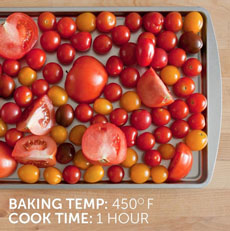TIP OF THE DAY: Oven-Roasted Tomatoes
|
When you encounter a bumper crop of tomatoes or see a great sale on tomatoes past their peak: roast them! You can use any fresh tomato: beefsteak, cherry, grape, plum, roma; conventional or heirloom. Healthful and delicious, you can serve them as a side with anything, add them to salads and pasta, serve them with a cheese course, and on and on. There are so many ways to use this basic recipe. Some of our favorites: This slow-roasted recipe requires 20 minutes prep time and 1 hour of cook time. It makes enough for leftovers, which can be added hot to pasta, cool to burgers, salads and sandwiches. Use them within a week. Roast a mix of sizes and colors for a more beautiful presentation. Ingredients For 10 Servings 1. PREHEAT the oven to 375°F with a rack in the center. Line a shallow roasting pan or rimmed baking sheet with parchment paper. 2. PREPARE the tomatoes: Wash, remove any stems and slice them in half lengthwise (with large tomatoes, make a few thick slices). Gently scoop out the seeds with a small spoon. Set the tomatoes, cut side up, in a single layer on the baking sheet. Drizzle with the olive oil and sprinkle with the thyme and garlic. 3. ROAST for 40 minutes, then increase the oven temperature to 400°F. Continue to until the tomatoes caramelize, about 20 minutes. 4. TURN off the oven and let the tomatoes sit inside for 10 minutes. Remove the pan to a rack and let cool completely. If you wonder why plum tomatoes (a.k.a. Italian plum tomatoes) and roma tomatoes look the same, it’s because for the most part, they are. The plum tomato can be oval or cylindrical, while the roma is oval or pear-shaped. Their vines are slightly different. They are meatier subspecies, with less liquid and seeds than other tomatoes. That’s why they’re preferred for canning and for tomato sauce. The scientific name of the tomato is Solanum lycopersicum. Individual sizes from cherry to beefsteak are subspecies of lycopersicum. Tomatoes are members of the Solanaceae family, popularly called the nightshades. Botanically they are berry*-type fruits. Other edible nightshades include eggplant, naranjilla, potato (but not sweet potato), tomatillo. Another popular nightshade is the chile pepper: hot and sweet varieties and the spices and condiments made from them, such as cayenne, chili powder, hot sauce and paprika. Tomatoes originated in the Andes Mountains of Peru, where thousands of different types grew wild. They were first cultivated by the Incas and spread to Central America, the Aztec Empire. |
|
|
|
The tomatillo (Physalis philadelphica), a cousin in the Solanaceae family, grew wild in Central America. It was cultivated by the Aztecs and called tomatl (pronounced to-MAH-tay). When the Aztecs began to cultivate the red berry* from the Andes, they called the new species xitomatl (hee-toe-MAH-tay), meaning “plump thing with navel” or “fat water with navel.” The Spanish arriving in what is now Mexico called the tomato tomatl (spelled tomate). The Spanish called the smaller green fruit, called tomatl by the Aztecs, tomatillo. Tomate first appeared in print (in Spanish) in 1595 [source and a deeper discussion]. |
||






